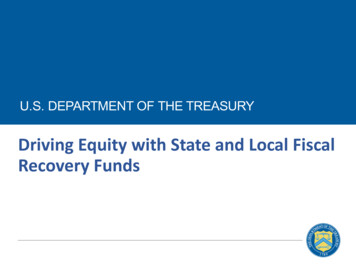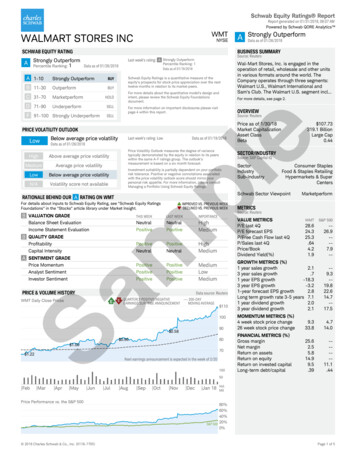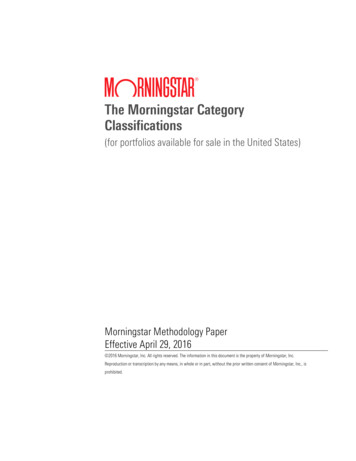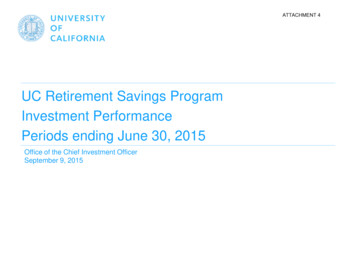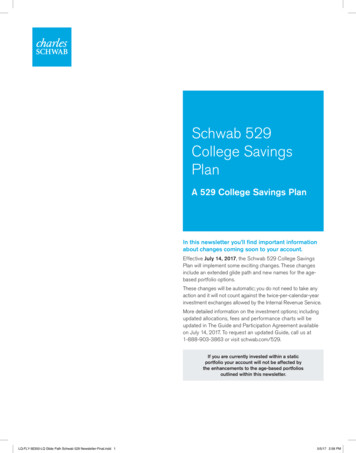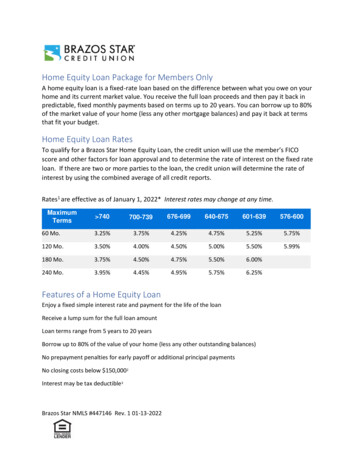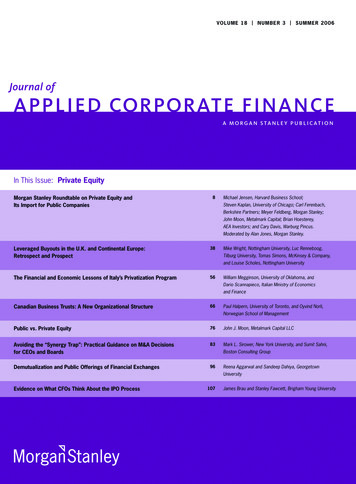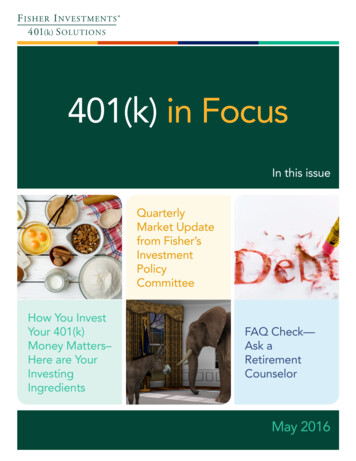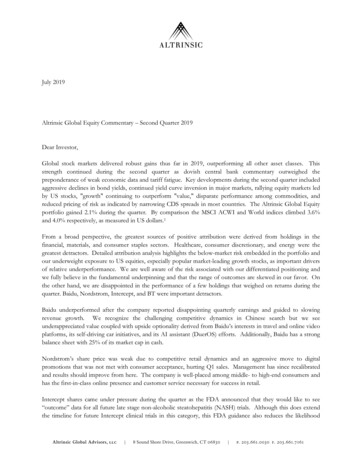
Transcription
July 2019Altrinsic Global Equity Commentary – Second Quarter 2019Dear Investor,Global stock markets delivered robust gains thus far in 2019, outperforming all other asset classes. Thisstrength continued during the second quarter as dovish central bank commentary outweighed thepreponderance of weak economic data and tariff fatigue. Key developments during the second quarter includedaggressive declines in bond yields, continued yield curve inversion in major markets, rallying equity markets ledby US stocks, "growth" continuing to outperform "value," disparate performance among commodities, andreduced pricing of risk as indicated by narrowing CDS spreads in most countries. The Altrinsic Global Equityportfolio gained 2.1% during the quarter. By comparison the MSCI ACWI and World indices climbed 3.6%and 4.0% respectively, as measured in US dollars.1From a broad perspective, the greatest sources of positive attribution were derived from holdings in thefinancial, materials, and consumer staples sectors. Healthcare, consumer discretionary, and energy were thegreatest detractors. Detailed attribution analysis highlights the below-market risk embedded in the portfolio andour underweight exposure to US equities, especially popular market-leading growth stocks, as important driversof relative underperformance. We are well aware of the risk associated with our differentiated positioning andwe fully believe in the fundamental underpinning and that the range of outcomes are skewed in our favor. Onthe other hand, we are disappointed in the performance of a few holdings that weighed on returns during thequarter. Baidu, Nordstrom, Intercept, and BT were important detractors.Baidu underperformed after the company reported disappointing quarterly earnings and guided to slowingrevenue growth. We recognize the challenging competitive dynamics in Chinese search but we seeunderappreciated value coupled with upside optionality derived from Baidu’s interests in travel and online videoplatforms, its self-driving car initiatives, and its AI assistant (DuerOS) efforts. Additionally, Baidu has a strongbalance sheet with 25% of its market cap in cash.Nordstrom’s share price was weak due to competitive retail dynamics and an aggressive move to digitalpromotions that was not met with consumer acceptance, hurting Q1 sales. Management has since recalibratedand results should improve from here. The company is well-placed among middle- to high-end consumers andhas the first-in-class online presence and customer service necessary for success in retail.Intercept shares came under pressure during the quarter as the FDA announced that they would like to see“outcome” data for all future late stage non-alcoholic steatohepatitis (NASH) trials. Although this does extendthe timeline for future Intercept clinical trials in this category, this FDA guidance also reduces the likelihood
that future competitors get early approval, further strengthening Intercept’s position in mid and late stageNASH markets.BT reported year-end results that were better than expected, but its shares underperformed as managementdelivered cash flow guidance that was below expectations and did not commit to maintaining the dividend if theconditions to invest in fiber are appropriate. At current levels, the market underappreciates BT’s strongcompetitive offering and Philip Jansen’s (BT’s new CEO) ability to improve BT's cost efficiency amidst aregulatory environment showing tangible signs of improvement.Notable gainers during the quarter included Nintendo, Qualcomm, and Yahoo Japan. Shares of Nintendoperformed well as it is set to release a new version of the Switch later this year. This should help to expand itsinstalled base ahead of a strong game release schedule, including Pokémon, Sword and Shield, and AnimalCrossing. Additionally, Nintendo is expected to release two mobile games in the coming months, Mario KartTour and Dr. Mario World. We see the potential for outsized profit growth as the company better monetizesits hardware platform. Initiatives in mobile gaming could further add to long-term value creation.Qualcomm shares rose after the company settled a long-running patent dispute with its largest customer, Apple.We sold our shares in the subsequent rally as it reflected the company's leading technology position in a nowmature smartphone market.Yahoo Japan’s majority holder, Softbank, shifted its ownership to a new entity, Softbank KK (Softbank Corp.’stelecom business), which also announced plans to share a much greater portion of the up-front investment inYahoo Japan’s costly mobile payment initiative. During this reorganization, Yahoo Japan repurchased 6% of itsown shares, in addition to the 11% it repurchased last year. Going forward, we expect the partnership toaccelerate growth in operating profits. Yahoo Japan’s shares remain attractively valued on what we consider tobe depressed earnings.Investment activity was robust as we added new positions in 8 companies during the quarter, including KBfinancial (Korea), THK (Japan), Fresenius Medical Care (Germany), Cognizant (US), Berkshire Hathaway (US),JB Hunt (US), Lowe’s (US), and Siemens (Germany). We sold Dufry (Switzerland), ING (Netherlands),Mitsubishi (Japan), Conduent (US), Alcon (Switzerland), and, as noted above, Qualcomm (US).Resulting portfolio exposures are illustrated in the charts and tables in the appendix. Notable sources ofexposure and differentiation versus broad market benchmarks include: 35% exposure to US companies, meaningfully below the 64% weighting of US stocks in the MSCIWorld Index. We see the greatest value and risk adjusted upside in non-US equities. Holdings in four industries represent approximately 73% of our invested capital: financials, healthcare,communication services, and consumer staples.2o Financials – Underweight European and US banks with exposure primarily among capital lightinsurers and non-bank, cash-flow-driven financials; overweight Japanese financials.o Healthcare – Invested in undervalued, established medical device and pharmaceutical companies,complemented by holdings in unique specialty pharmaceuticals, facilities, and other enterprises.o Communications – Exposure is among companies with shareholder-friendly management teams,strong balance sheets, and ownership of premier network, technology and/or content assets.o Consumer Staples – Meaningful positions in well-capitalized European-based multinationalfranchises.
Our direct emerging market exposure is a modest 5%, however, we see a growing number ofopportunities following years of EM underperformance and short-term macro uncertainty.Macro uncertainty is also leading to opportunities in the industrials and materials sectors. We arespending more time conducting due diligence in these areas and expect to capitalize should furthervolatility arise.Market Commentary/Investment PerspectivesAlthough many investors are taking great comfort in lower interest rates and dovish policy comments, theypresent a delicate situation with fragile underpinnings. As illustrated in Charts 1 & 2* disinflationary and/ordeflationary concerns are prevailing, likely caused by mountainous debt levels, the extended nature of thiseconomic expansion, demographics, globalization, automation, and technological innovation. But, as articulatedin previous commentaries, the tug-of-war between these pressures and inflationary forces (including those thatcould stem from expansive unorthodox monetary policy experimentation) will play out over the medium tolong term and be a key source of both interest rate and market volatility in the years ahead.Chart 1: 5-Year / 5-Year Forward CPI Swap Rate: EUR3.0Chart 2: U.S. 5-Year / 5-Year TIPS Breakeven Inflation32.522.01As of 06/30/19; Source: Bloomberg201 9201 5201 10200 7201 9201 6201 4201 2201 0200 71.0200 31.5As of 06/30/19; Source: FRED*5 year/5 year forward CPI swap rates and 5 year TIPS breakeven are market proxies for inflation expectations.Central bank policy and commentary have further contributed to inverted and flat yield curves as seen in Charts3 & 4. Speculation swirls around the origin and significance of inverted yield curves, but they have often been aleading indicator of economic weakness or recessions. These conditions are particularly difficult for banks,which have performed terribly for years. Our limited exposure to banks has been primarily in Japan, but weexpect opportunities to emerge in the western banks.Overall, the suppression of interest rates and "extraordinary" stimulus has succeeded in one thing for sure:lifting asset prices. Since the 2008 crises, the big 5 central banks have bought 12.4 trillion in assets. However,the corresponding rise in debt levels (global debt to GDP has climbed from 190% to 235%) and underlyingcomposition created vulnerabilities that could be amplified during an economic downturn and corporatebankruptcies could surprise in magnitude.
Chart 3: United States Yield CurveCurren t3m agoChart 4: Eurozone Yield Curve1yr agoCurren t3.00.52.50.03m ago1yr ago2.12.0(0.3)(0.5)2.0(0.6)(0.8)3m10y2y3m(1.0)As of 06/30/19; Source: FactSet10y1.52y1.7As of 06/30/19; Source: FactSetChina in particular has experienced a significant increase in debt. Recognizing this, officials attempted adeleveraging campaign last year, but deteriorating growth forced them to quickly reverse course, providingadditional fiscal stimulus and liquidity in the banking system. Despite these efforts, banking regulators had tobail out Baoshang Bank, the first Chinese bank to default, in May. China has the resources and tools to avoid afull-blown crisis, but the imbalances are significant and will persist for years. Similarly, the government’sconflict with the West in areas of trade, intellectual property rights, cyber warfare, and geopolitical influence willbe long-lasting.Despite the swoon experienced during the fourth quarter, the market rally since has led to significantcomplacency among investors and market observers. Valuations are elevated, particularly for popular "growth"stocks. Risk measures like junk bond spreads and credit default swaps for leveraged countries and companies,not to mention a record 13 trillion of negative yielding bonds highlight major imbalances in global markets.Subdued capital expenditures suggest corporates have been conservative in their outlooks and planning, buttheir appetite to borrow and increase leverage suggests confidence and/or macro complacency. We have noability to forecast economic variables, but we believe it is particularly timely and prudent to be conservative inour assumptions for economically sensitive businesses and in our risk assumptions.While we recognize the significant issues facing investors, we believe that public equities are well-suited todeliver favorable absolute returns over the long term and outperform most other asset classes. This will comewith volatility, as seen last year, and there will be winners and losers. While the pace of innovation isaccelerating, well-managed companies can adapt to evolving economic and competitive environments, innovate,enter new markets, and allocate capital to enhance shareholder value. A few large tech companies have beengenerating significant buzz surrounding their innovation and market dominance, but beneficiaries are spreadingacross all industries. We believe some of the greatest surprises will come in healthcare, where focusedmanagement helps catalyze and harness scientific innovation. We are also encouraged by the greater alignmentwith shareholder values, not only in economic terms but regarding important environmental, social, andgovernance issues as well.***On a final note, we are pleased to inform you that we have repurchased National Australia Bank's minorityinterest in our firm.
Trends in asset management have led many participants to exit the industry, consolidate via mergers andacquisitions, and/or pursue other defensive strategies as they confront skepticism towards active managementand threats from passive, low-cost "factor oriented solutions." To the contrary, we believe there is no bettertime to invest in ourselves.We will continue to work closely with NAB's wealth management arm, MLC, in the Australian marketplacewhere we manage the Altrinsic Global Equities Trust and other offerings. Under the new leadership of GeoffLloyd, we are confident that MLC's wealth management business will continue to positively distinguish itself inthe local marketplace.This purchase will enable us to further incentivize the next generation of talent while even more deeply aligningour interests with those of our clients. We have been partners for 19 years and have since surrounded ourselveswith a terrific and diverse team of younger professionals who are playing important roles at Altrinsic. With thistransaction, the team will eat even more of its own cooking.We launched Altrinsic in 2000, as the TMT bubble was unraveling and the cognoscenti were calling for the"death of value investing." Many value investors did capitulate during this period given short-term relativeperformance pressures, the prolific leadership by a narrow group of high-priced "growth/momentum" stocks,and emotions throughout the industry food chain. Sound familiar?Benjamin Graham famously said, "An intelligent investor gets satisfaction from the thought that his operationsare exactly opposite to those of the crowd." The confidence we had in 2000 is outweighed by the confidence wehave today.We are humbled by the challenge, exhilarated by the opportunity, and could not be more excited for what liesahead.Sincerely,John HockJohn DeVita1Performanceis presented gross of management fees for the composite and includes the reinvestment of all income. Gross returns will be reduced by investmentadvisory fees and other expenses that may be incurred in the management of the account. Past performance is not indicative of future results. The outlook andopportunities noted throughout this letter are the opinions of Altrinsic as of the date of this letter. There is no guarantee that we will be successful in implementinginvestment strategies that take advantage of such perceived opportunities. Please see Important Considerations and Assumptions at the end of this letter foradditional disclosures.2Industry/Sector/Regional portfolio weights included here and throughout this letter are presented as of June 30, 2019. Altrinsic independently analyzes eachsecurity recommended for purchase and categorizes it into the MSCI GICS sector and or country that it deems most appropriate. Altrinsic's sector and countryclassification may differ from MSCI. These percentages are based upon a representative fully discretionary account.
Altrinsic Global Equity CompositeQuarterly Report as of June 30, 2019Benchmark: MSCI WorldCurrency: USDInception Date: 6/30/2000Region WeightsPerformance (%)AnnualizedPortfolio1 Year3 Year5 (1.1)(0.9)2.0Portfolio18%BenchmarkBenchmark60% Market ValueYTDExcess7 Year 10 YearSinceIncepQTD16%504030201014%CashEmerging Mkts4%Pacific Ex Japan6%United Kingdom8%Europe Ex UKNorth America10%Japan012%2%0%Sector ortfolioBenchmark30Top 10 Positions2.7SanofiHealth Care2.7Astellas Pharma Inc.Health Care2.6GlaxoSmithKline plcHealth Care2.4Aon plcFinancials2.3Heineken NVConsumer Staples2.1Hartford Financial Services.Financials2.025.5%Positions Initiated/Eliminated (2nd Quarter s Towers Watson PLCMaterialsZurich Insurance Group AG15Information Technology2.8IndustrialsFinancialsHealth CareChubb Ltd.20Financials3.0EnergyCommunication ServicesConsumer StaplesComcast Corp.Consumer Discretionary% Market ValueCommunication ServicesSector% Market HK Co. Ltd.ING Groep NVPortfolioBenchmarkKB Financial Group Inc.Conduent Inc.Weighted Average (USD M)68,204167,380Cognizant Tech Solutions-AQualcomm Inc.Fresenius Medical Care AGDufry AGPortfolio CountMedian (USD M)34,99713,16478Berkshire Hathaway Inc.-CL BMitsubishi Corp.Dividend Yield2.6%1,6552.4%J.B. Hunt Transport Services, .Price to Earnings16.6x18.5xSiemens AGPrice to Book1.8x2.4xMarket CapLowe's Companies, Inc.Performance is presented gross of management fees but net other fund expenses. Gross returns will be reduced by the investment advisory fee. The report reflects the composite inception date and performance. Individualclient inception dates and since inception returns will vary. The portfolio may invest in countries, sectors and securities not included in the noted index. All investments involve risk of loss. Past performance is notindicative of future results. Due to rounding, numbers presented may not add up to the totals provided. 2019 Altrinsic Global Advisors, LLC
Baidu, Nordstrom, Intercept, and BT were important detractors. Baidu underperformed after the company reported disappointing quarterly earnings and guided to slowing . additional fiscal stimulus and liquidity in the banking system. Despite these efforts, banking regulators had to bail out Baoshang Bank, the first Chinese bank to default, in .

